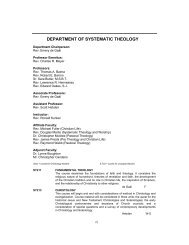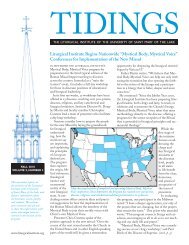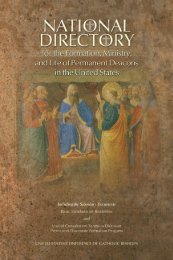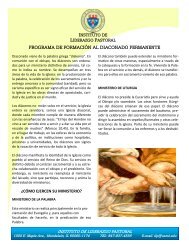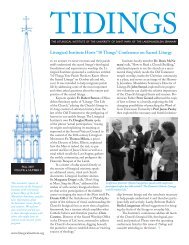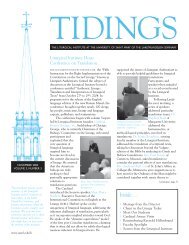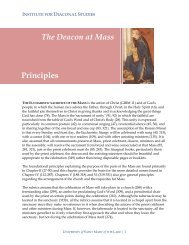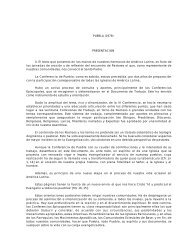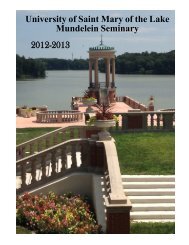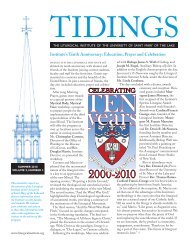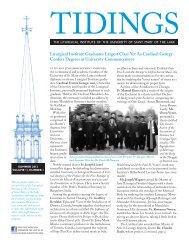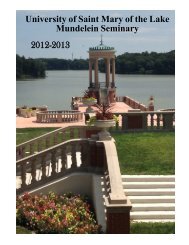Volume Five, Number 3, Fall 2006 - Mundelein Seminary
Volume Five, Number 3, Fall 2006 - Mundelein Seminary
Volume Five, Number 3, Fall 2006 - Mundelein Seminary
You also want an ePaper? Increase the reach of your titles
YUMPU automatically turns print PDFs into web optimized ePapers that Google loves.
TIDINGSTHE LITURGICAL INSTITUTE OF THE UNIVERSITY OF SAINT MARY OF THE LAKE/MUNDELEIN SEMINARYInstitute Hosts “Heaven on Earth” Church Architecture ConferenceFALL <strong>2006</strong>VOLUME 5, NUMBER 3This newsletter reports onthe activities of the LiturgicalInstitute of the Universityof Saint Mary of the Lake/<strong>Mundelein</strong> <strong>Seminary</strong>, andfeatures information aboutthe Institute’s events, faculty,and students. We welcomeyour comments and ask youto share this information withothers who might have aninterest in the mission of thisprogram.www.liturgicalinstitute.orgTHE LITURGICAL INSTITUTE’S FOURTH conferenceon Catholic architecture commenced onOctober 25, 2007, bringing speakers and over 100participants from around the United States andCanada to discuss the intersection of sacramentaltheology of the liturgy with the practice ofchurch building. Entitled “Heaven on Earth,”the conference sprang from the idea emphasizedat the Second Vatican Council that liturgical artand architecture should make known the “signsand symbols of heavenly realities” (SacrosanctumConcilium, 122).Keynote speaker David Fagerberg, AssociateProfessor of Theology and Director ofthe Center for Liturgy at the University ofNotre Dame, spoke on the topic of liturgy asheaven on earth. He claimed that there are nottwo liturgies, one in heaven and one on earth,but one liturgy which joins the two in praise ofGod. He challenged the architects and buildingcommittees in the audience to think of art,architecture and all of creation in terms of its“liturgical end” to give glory to God and bringabout the divinization of humanity. It is therole of artists and architects, he said, to useliturgical art and architecture to “visual-ize”the liturgy in the same way the liturgy itself“symbol-izes” the Kingdom.Other speakers in the conference combinedtheoretical and practical material, helpingarchitects and parishes to think sacramentallyabout their designs and plan for the reallifecontingencies of church construction. LiturgicalInstitute faculty member and architecturalhistorian Denis McNamara offered a talkentitled “Good Traditional, Bad Traditional” inwhich he explained the structural and ornamentaltheory behind traditional architecture, urgingcongregations which desire a traditional buildingto hire an architect who specializes in that sort ofdesign. Architect Ethan Anthony, of HDB/Cram and Ferguson Architects in Boston, followedwith a talk entitled “Affording the Tradition”which explained that traditional architectureis affordable, and how careful design andFr. Thomas Loya addresses the participants of the “Heavenon Earth” conference on Catholic liturgical architecture.material selection can dramatically lower the finalcost of a building. With images and examplesfrom his own church projects, he showed reallifeexamples where creative use of both modernand traditional materials could not only keep thebudget numbers in line, but make a more beautifulchurch building.Christopher Carstens, Director of the SacredWorship Office of the Diocese of Lacrosse,addressed the architectural legislation found inthe General Instruction of the Roman Missal, explainingthe theological basis for the Church’srules. Cistercian monk Mark-Daniel Kirby’s address,“More Than A Sound Meter,” tackled thetopic of the theology of church acoustics, discussingthe need for a building which supportsthe sung liturgy. Professional fund-raiser RitaPerret of Century Philanthropy Group then explainedhow to launch and manage a capitalcampaign, and how a beautiful church designwill assist in the process of raising funds.(continued, page 2)
Fr. Douglas Martis, a priest ofthe Diocese of Joliet, holds anS.T.D. with a concentration inSacramental Theology from theInstitut Catholique de Paris anda Ph.D. in History of Religionsand Religious Anthropologyfrom the Sorbonne.From the DirectorOVER THE COURSE OF THE PAST SEVERAL months Ihave had the opportunity to spend time with awide variety of people engaged in liturgical renewalaround the world. The Federation of DiocesanLiturgical Commissions National Meeting,hosted this year by the Archdiocese ofOmaha, gave the Liturgical Institute the chanceto feature the <strong>Mundelein</strong> Psalter and to explainour work with conferences and programs. Whatbecame evident was the great need to foster liturgicalstudies and to encourage young peopleto pursue careers in sacramental theology. InOctober I participated in the celebration for the50th anniversary of the Institut Supérieur de Liturgiein Paris, France and delivered a paper onthe formation of priest “liturges.” The gatheringof 600 included bishops and scholars fromaround the world. Seated with Père Louis MarieChauvet Dom Philippe DuPont, Abbot ofSolesmes, I began to understand that this wasperhaps the most important gathering of liturgistsand sacramental theologians since the yearsimmediately after the Council.There is new energy, a new hope amongscholars that a deeper understanding of the liturgyis close at hand. The current work of theseresearchers is aimed at fostering the greatlyneeded internal participation which is the necessaryprelude to conscious external expression.One of the unfortunate, (but we hope temporary),results of current conflicts concerning theliturgy is that they tend to highlight the externalexpression— reinforcing the notion of ceremony—and thus stealing attention from the theologicalmeaning of the Church’s prayer. Two examplesmight serve to illustrate this point: Insome places, the implementation of the InstitutioGeneralis risks being little more than following“new rules” without a deeper reflection on themeaning and ritual importance of certain gestures,actions, and postures. For others, anxietyabout new translations often leads to discussionsabout words, yet rarely is the opportunity takento discuss the rich theology behind the Church’slanguage and concepts. Yet the aim of these initiativesis precisely to reveal the layers of meaningin the liturgy, its history, scriptural basis, patristicroots and theology.The rubrics are best when followed unobtrusively,without calling attention to themselves.This, of course, can only happen over time. Theactions, postures and gestures need “to get intoour bones” so that they happen effortlessly. Liturgicaltranslations are best when they lead usto a more profound understanding of the mysterywe celebrate. In both instances, the initialchanges require attention to what is said and towhat is done. Catholic liturgy is designed forthose who engage it over the long-haul, withdiscipline, patience and humility. Like the scriptures,the liturgy reveals its proper beauty on itsown terms. Thus it is a inexhaustible source ofreflection and grace. The future of the Church’sprayer will be well served if we can devote ourselvesto a sustained, consistent contemplation ofthese mysteries.Architecture Conference, continuedByzantine-rite Catholic priest, radio personality, and noted iconographer Fr. ThomasLoya explained the “Theology of the Image” in the eastern and western traditions,urging participants to see the world in liturgical terms and understand the churchbuilding in particular as an image of heaven made known sacramentally to the earthlycongregation.The conference finished with two practical talks, one by Jeff Greene, president ofEvergreene Painting Studios, and the other by William Buckingham of S/L/A/M Architectsof Boston. Greene showed images displaying the revival of craft in ecclesiasticalwork today, discussing how a parish may want to proceed in commissioning artisticwork in renovation or new construction, showing examples of his firm’s work and thatof other artists and craftspeople. Buckingham, who specialized in Catholic church designwhile working for Keefe Associates Architects, walked the participants through a“beginning to end” church building project, explaining how one may want to choose acontractor as well as placate the zoning commissions and fire safety boards.Rita Perrett and Christopher Carstens answerquestions from conference participants.The conference sessions were punctuated by sung Lauds and Vespers using tones from the Institute’s forthcoming <strong>Mundelein</strong>Psalter, as well as sung Mass with Fr. Mark Daniel Kirby as principal celebrant. Several of <strong>Mundelein</strong>’s seminarians acted as servers,masters of ceremonies, and cantors. Participant comments were overwhelmingly positive, praising the balance between theoreticaland practical information and the opportunity to meet and network with peers in the field of sacred art and architecture.The Liturgical Institute offers its warm gratitude to Mr. John B. Powers and the Bricks and Mortar Foundation for a grant to helpunderwrite the Heaven on Earth conference.
Institute Hosts Exhibit and Seminar on Liturgical Reformer and Social Justice AdvocateMonsignor Reynold Hillenbrandthe liturgical institute erected the first full exhibit in the new McEssy Theological Resource Center on MonsignorReynold Hillenbrand, Rector of St. Mary of the Lake <strong>Seminary</strong> in <strong>Mundelein</strong> from 1936 to 1944. A pioneer of liturgical reform in boththe seminary and the Archdiocese of Chicago, Hillenbrand was also a speaker and author of national significance, having helped toform the National Liturgical Weeks, the Catholic Family Movement, and the Young Catholic Workers. Fiercely loyal to the Churchand the pope, Hillenbrand agitated for greater participation of the laity in the holy mysteries of the Church so that they could drinkmore deeply form the font of divine life. He believed that Christians transformed by thegrace found in the liturgy would then see Christ in their neighbors, bring about aChrist-centered reconstruction of the social order. A friend and collaborator of otherLiturgical Movement notables like Virgil Michel and Godfrey Diekmann, Hillenbrandalso invited Dorothy Day to speak at <strong>Mundelein</strong>, making her the first woman ever toaddress students at an American seminary.With information and artifacts drawn from the Archives of the University of NotreDame, the seminary’s own collection, and Sacred Heart parish in Hubbards Woods,Illinois, where Hillenbrand served as pastor for thirty years, the exhibit displayedartifacts such as Hillenbrand’s cassock, ciborium and sick call set, historic photographs,excerpts from his writings, and sounds clips from one of his 1957 speeches. The exhibitwas written and designed by LiturgicalInstitute faculty member DenisMcNamara.In conjunction with the exhibit,the Institute sponsored a seminar withFr. Robert Heidenreich and parishionersfrom Sacred Heart Parish, many ofwhom knew Hillenbrand personallyMonsignor Reynold Hillenbrand in the 1950s.before his health in 1979. InstituteDirector Fr. Douglas Martis offered alecture on the Liturgical Movement ofthe twentieth century, its beginnings in Europe, the papal documents which gave itofficial approval, and its spread in the United States through the influence of reformerslike Hillenbrand. He then explained the intimate link between liturgical participationand social justice as preached by Hillenbrand.For Hillenbrand social justice was not so much about the government enforcinglaws as it was about the transformation of individuals through the “Christ-life”dispensed in the sacraments, particularly the Eucharist. It was therefore urgent thatCatholics participate actively in the liturgy so that they might gain the grace and revealthe fruits of Christ’s passion, death and resurrection. Transformed Christian wouldthen go out and bring about a social reconstruction not based on the collectivism ofsocialism, but on what he called the “corporateness” of the Mystical Body of Christ.These thoughts continued through the documents of the Second Vatican Council, inwhich the laity were encouraged to be transformed through active participation in theliturgy and then bring their renewed selves to the task of evangelizing the secularworld.The exhibit is available in an on-line version at the Liturgical Institute’s web site,www.liturgicalinstitute.org, where visitors may also leave written memories ofMonsignor Hillenbrand to be added to the exhibition.In order to keep alive the memory of Monsignor Hillenbrand, the LiturgicalInstitute has established a Hillenbrand Scholarship Fund for the laity to study at theLiturgical Institute. For further information on this worthy goal or to make a donation,please call the Institute at 847.837.4542.Visitors from Sacred Heart parish in Winnetka,Illinois view the Liturgical Institute’s exhibit onReynold Hillenbrand.Sacred Heart parish pastor Robert Heidenreichlistens to a speech given by Hillenbrand in 1957.
Sister Sara Butler Discusses The Catholic Priesthood and WomenSr. Sara Butler returns to <strong>Mundelein</strong> topresent a lecture from her upcoming bookThe Catholic Priesthood and Women: AGuide to the Teaching of the Church.AS PART OF THE HILLENBRAND DISTINGUISHEDLecture Series, the Liturgical Institute welcomeda group of nearly 100 students and faculty to heara presentation by Sr. Sara Butler, MSBT based onher forthcoming book The Catholic Priesthood andWomen: A Guide to the Teaching of the Church tobe published by Hillenbrand Books inFebruary of 2007.Sr. Sara opened her presentationby relating how for years she hadsupported the movement for women’sordination, regarding it as regardedthis as a litmus test of equality betweenwomen and men in the Church. Sheconcurred with the conclusion of aTask Force of the Catholic TheologicalSociety of America (1978), which shechaired, that available evidence favoredthe admission of women to priestlyordination.She recalled that upon thepublication of Pope John Paul II’s“theology of the body” and his responseto the feminist critique in theapostolic letter Mulieris dignitatem(1988), her remaining misgivings about theadequacy of the Church’s teaching on women’sfull equality with men were dissipated. Whengiven a second opportunity to review the questionof women’s ordination, this time withcolleagues on the Anglican-Roman CatholicInternational Commission, she saw more clearlyhow the Catholic doctrine on this matterpertained to the constitution of the Church.In her talk, Sr. Sara explained clearly thatthe question of ordaining women raises again thecontested issues of the Reformation. Thoseissues concern not the complementarity of thesexes but the constitution of the Church and thesacramentality of the priesthood. She made clearfor the overflow audience that the “fundamentalreasons” for reserving the ministerial priesthoodto men grow from scripture and the unchangingtradition of the Church rather than the theologicalarguments presented in recent years. Centralto acceptance of this teaching is an a prioriacceptance of Tradition as authoritative and anunderstanding of holy orders as distinct from thepriesthood of the baptized.Sr. Sara’s Hillenbrand Lecture provided asolid, reasoned theological orientation to theteaching of the Catholic Church regarding theordination of women to the priesthood, and didit in a way that engaged directly the chiefobjections that are raised by its critics of theChurch’s teaching. She identified the centralissues and proposed an analysis that supportsCatholic doctrine and discipline. She did notmerely defend the status quo, but advocated thefull, practical implementation of the life-giving,liberating potential of the Gospel that theCatholic Church holds out for women. Liturgical Institute Faculty Spotlight: Fr. Eugene Morristhe liturgical institute introduces fr. eugene morris as visiting faculty member.Having taught for the Institute in the summer and fall of <strong>2006</strong>, he finds the opportunity topractice the “pure art” of teaching at the Liturgical Institute edifying. He hopes to provide anenvironment where students can synthesize Church teaching with their own personal appropriation.Well known for his weekly radio show on sacramental and liturgical theology and asspiritual director for “The Inner Life” on Relevant Radio, he is a highly sought after speakeracross the Archdiocese of St. Louis and beyond.Fr. Morris brings a wealth of education and teaching experience to the Liturgical Institute.He holds two Bachelor of Arts degrees from Saint Louis University, one in English, theother in Philosophy, and a License in Sacred Theology from the Pontifical Athenaeum ofSant’Anselmo in Rome. He also holds a Master of Divinity and Master of Arts in ChurchHistory from Kenrick Glennon <strong>Seminary</strong> and is currently engaged in doctoral studies at theInternational Marian Research Institute.When not teaching at the Liturgical Institute, Father Morris is the Director of St. Maximilian Kolbe House of Discernmentat Kenrick Glennon <strong>Seminary</strong>, the Episcopal Vicar and Director for the Office of the Permanent Diaconate, and Directorof Liturgical Formation for the Permanent Diaconate for the Archdiocese of St. Louis. He is also an Assistant Professor atKenrick Glennon <strong>Seminary</strong>, a Lecturer at Paul VI Catechetical Institute, and a columnist and Editorial Board member for theSt. Louis Review. “Teaching theology,” says Morris, “is not simply imparting information—but also deals with the soul—the humanspirit in relation to God.” Father Morris finds the students at the Institute intellectually engaged, enthusiastic, and faithfulto the Church.
Institute Sponsors Second Chant WorkshopDr. Edward Schaefer offers the keynote addressof the Institute’s conference on Gregorian chant.on september 17, <strong>2006</strong>, the institute welcomedDr. Edward Schaefer to lead “Pride ofPlace: Gregorian Chant in the Liturgy,” a threedayworkshop intended to address the growingrenewal of sung liturgy in parishes across the nation.Taking its name from SacrosanctumConcilium which asks thatGregorian chant be given “pride ofplace in liturgical services,” theevent both laid the theologicalfoundation for sung liturgy andaddressed the practical aspects ofsinging Gregorian chant.In his keynote address,Schaefer began by proposing howparticipants might reconcile twostatements from the Second VaticanCouncil. First he mentionedSacrosanctum Concilium number14, which states that active participationin the liturgy is the aim to be consideredbefore all else, and also number 116 which asksthat Gregorian chant be given “pride of place inliturgical services.”Schaefer found an initial response to thisquestion by referring back to Pius X’s 1903 motuproprio Tra le sollecitudini, which used the term“active participation” particularly in restoring tothe people the sung parts of the Mass proper tothem. He then traced the recurrence of this idea inthe writings of Pius XI and Pius XII, the 1958 instructionMusicam Sacram, and Vatican II itself.Schaefer then discussed the nature of chant,calling it the music of the Church which has noother connotation, existing only in the liturgy. Healso praised chant for intimately intertwining textand music, unlike some hymns which take seculartunes and puts words to them.In the course of the conference, participantswere treated to separate workshops for both advancedand beginning singers, allowing some tolearn to read the basic chant notation and othersto learn the phrasing and interpretation of eventhe most complex lines. The Institute thanks Dr.Schaefer and his two assistants, Colleen Carterand Margaret Rankin for bringing their expertiseto this event. Margaret Rankin leads a break-out session on readingchant notation.Fr. Martis Blesses Institute’s New Portative Pipe Organin its continuing effort to support the liturgical life of its students, the Liturgical Institute commissionedBerghaus Organs of Bellwood, Illinois, to design and construct a small pipe organ for use in the University’s Chapel of the ImmaculateConception. During the University’s October 21st Sunday Mass, organized by the Liturgical Institute, Fr. Martis usedthe “Order for the Blessing of an Organ” from the Book of Blessings, using the prescribed words: “my dear brothers and sisters, wehave come together to bless this new organ, installed so that the celebration of the liturgy may be more beautiful and solemn. The purposeof music in the liturgy is above all to give glory to God and lead us to holiness.” The Sunday schola, organized by Liturgical Institutefaculty members Linda Cerabona and Denis McNamara and composed of <strong>Mundelein</strong> seminarians, sang the chant settings ofthe proper texts of the Mass composed by FatherSamuel Weber, osb.The 5-rank organ contains 270 pipes, eachcarefully selected and voiced to complement thelush acoustic and 4-second reverberation of thechapel. Originally intended to support the singingof the Liturgical Institute’s daily schedule ofLauds and Vespers, the instrument has been discoveredby organists on campus. Though smallin size, its bright, custom-designed tone hasmade it a favorite for other liturgical uses as well.The Liturgical Institute welcomes donations tohelp defray the cost of the organ. If you wouldLiturgical Institute director Fr. Douglas Martis blesses the new portative organ, whileInstitute music director Linda Cerbona plays it for the first time.like to make a contribution to the organ fund,please contact us at 847.837.4542.
Scenes from the Liturgical Institute(left to right): Attendees of the Institute’s seminar on Reynold Hillenbrand chant midday prayer at Hillenbrand’s grave; Institute faculty member DenisMcNamara speaks at the Institute’s “Heaven on Earth” Architecture Conference; Director Fr. Douglas Martis opens the Institute’s chant workshop.(left to right): Fr. Mark Daniel Kirby celebrates Mass at the Institute’s “Heaven on Earth” architecture conference; Hillenbrand Lecturer Sr. Sara Butlerspeaks with seminarians after her talk; Fr. Robert Heidenreich and members of Sacred Heart Parish in Winnetka, Illinois discuss memories ofHillenbrand at the Institute’s exhibit entitled “Monsignor Reynold Hillenbrand and the Sacred Liturgy.”TIDINGSUNIVERSITY OF SAINT MARY OF THE LAKETHE LITURGICAL INSTITUTE1000 East Maple Avenue<strong>Mundelein</strong>, Illinois 60060www.liturgicalinstitute.orgNonprofit OrganizationU.S. POSTAGE PAIDMUNDELEIN, ILPERMIT NO. 103



